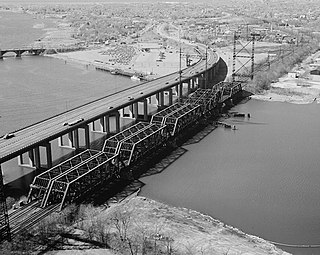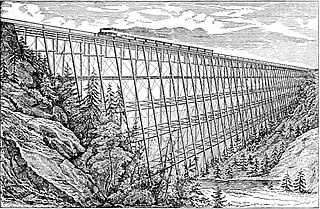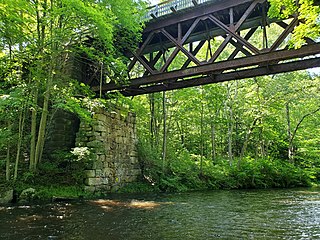
The Moodna Viaduct is an iron railroad trestle spanning Moodna Creek and its valley at the north end of Schunemunk Mountain in Cornwall, New York, near the village of Salisbury Mills.

A trestle bridge is a bridge composed of a number of short spans supported by closely spaced frames. A trestle is a rigid frame used as a support, historically a tripod used to support a stool or a pair of isosceles triangles joined at their apices by a plank or beam such as the support structure for a trestle table. Each supporting frame is a bent. A trestle differs from a viaduct in that viaducts have towers that support much longer spans and typically have a higher elevation.

The New York and New England Railroad (NY&NE) was a railroad connecting southern New York State with Hartford, Connecticut; Providence, Rhode Island; and Boston, Massachusetts. It operated under that name from 1873 to 1893. Prior to 1873 it was known as the Boston, Hartford and Erie Railroad, which had been formed from several smaller railroads that dated back to 1846. After a bankruptcy in 1893, the NY&NE was reorganized and briefly operated as the New England Railroad before being leased to the competing New York, New Haven and Hartford Railroad in 1898.

The Air Line State Park Trail is a rail trail and linear state park located in Connecticut. The trail is divided into sections designated South, North a piece of the East Coast Greenway, and the Thompson addition. An additional 3.6 mile spur to Colchester is sometimes designated as part of the Air Line trail. At the Massachusetts state line, the trail connects to the Southern New England Trunkline Trail, a 22 mile long trail to Franklin, MA built on the same right-of-way. Since 2018, the town of Portland, CT has also maintained a 2.3 mile portion of the Airline Trail, connecting to the southern end of the state park at the town line with East Hampton.

The Willimantic Footbridge is a pedestrian bridge in the Willimantic section of Windham, Connecticut. Built in 1906, it extends from Main Street southward, across Riverside Drive, railroad tracks, and the Willimantic River, connecting downtown Willimantic to the residential area south of the river. It is one of a small number of pedestrian bridges built in the early 20th century to survive in the state. It was listed on the National Register of Historic Places in 1979.

The Riverside Avenue Bridge is the only cast-iron bridge in Connecticut and one of a small number still in use in the United States. It carries Riverside Avenue over the New Haven Line railroad tracks in the Riverside section of Greenwich, Connecticut. The bridge was part of an earlier span built in 1871 over the Housatonic River by the New York and New Haven Railroad, and when that bridge was replaced, part of it was erected in Riverside in 1895. It was placed on the National Register of Historic Places in 1977.

The Blackstone Viaduct, or the New York & New England Railroad Viaduct is a historic viaduct in Blackstone, Massachusetts. The viaduct was built in 1872 by the Boston, Hartford and Erie Railroad and the American Bridge Company. The viaduct is 1,600 feet (490 m) long structure, consisting of masonry arches and earthen embankments in the Massachusetts portion of the village of Waterford. It runs from the Blackstone River in the east to a still-watered section of the defunct Blackstone Canal to the west. The most prominent portion of the structure is an 800-foot earthen embankment running west from the river that is 25 feet (7.6 m) high, and then a 375-foot (114 m) multiple-arch masonry bridge constructed out of granite which was sheathed in concrete in 1918. The structure was listed on the National Register of Historic Places in 2002.

The Housatonic River Railroad Bridge is a historic bridge carrying Metro-North Railroad's New Haven Line trackage across the lower Housatonic River in the U.S. state of Connecticut. The bridge is also used by Amtrak for its Northeast Corridor services. It was listed on the National Register of Historic Places in 1987, which also refers to the bridge as the Devon Bridge. It is also referred to as the Devon Railroad Bridge by the state Department of Environmental Protection.

The Lyman Viaduct is a buried railroad trestle built over Dickinson Creek in Colchester, Connecticut in 1873. Along with the nearby Rapallo Viaduct, it is one of the few surviving wrought iron railroad trestles from the first generation of such structures. It was built for the Boston and New York Air-Line Railroad, whose successor, the New York, New Haven and Hartford Railroad (NYNH&H), buried it in sand rather than replacing it with a stronger structure. The viaduct was added to the National Register of Historic Places in 1986, since it is capable of providing detailed information about construction methods of the period. The viaduct now carries the multiuse Air Line State Park Trail.

The Blackledge River Railroad Bridge is a Warren truss bridge that was built on the site of a c. 1870 railroad bridge. The original bridge was completed and opened by August 3, 1877. Likely built by the Colchester Railway Company, the bridge was part of the 3.59 miles (5.78 km) of track from Colchester, Connecticut, to Turnerville. The line was leased to the Boston & New York Air Line Railroad and reported improvement in 1879 and a new 110-foot long (34 m) iron bridge by 1881. The line was leased to the New York, New Haven and Hartford Railroad in 1882. After dominating the region, the New York, New Haven and Hartford Railroad petitioned for changes to the Air Line and the approval came on July 7, 1911.

East Hampton is a town in Middlesex County, Connecticut, United States. The population was 12,717 at the 2020 census. The town center village is listed as a census-designated place (CDP). East Hampton includes the boroughs of Cobalt, Middle Haddam, and Lake Pocotopaug.

The Boston and New York Air-Line Railroad was a railroad in Connecticut. Envisioned as a direct route between New Haven and Boston, it was hampered by difficult terrain in eastern Connecticut and did not find much success. The New York, New Haven and Hartford Railroad leased the company in 1882. The tracks between Portland, Connecticut and Willimantic, Connecticut were abandoned in 1965, while the remainder of the line is operated by the Providence and Worcester Railroad.

The East Putney Brook Stone Arch Bridge is a historic stone arch bridge in eastern Putney, Vermont. Built in 1902, it is a rare statewide example of a 20th-century stone bridge, and one of a number of such area bridges built by Townshend farmer and mason James Otis Follett. It was listed on the U.S. National Register of Historic Places in 1976. The bridge is located just west (upstream) of the present alignment of River Road, which it formerly carried.
The Shore Line Electric Railway was a trolley line along the southern coastline of Connecticut, running between New Haven and Old Saybrook with additional branches to Chester and Stony Creek. Unlike most trolley lines in New England, the Shore Line Electric was a true interurban, running large railway-style cars largely on a private right-of-way rather than on public streets. Though its main line was in operation for only 15 nonconsecutive years, the Shore Line Electric briefly acquired a substantial network of trolley lines stretching across eastern Connecticut, including the Norwich and Westerly Railway, the Groton and Stonington Street Railway, and several lines of the Connecticut Company. Most of the trolley line no longer is extant, however, the Shore Line Electric Railway Power House still stands along the mouth of the Connecticut River in Old Saybrook.

The Little Pipe Creek bridge and viaduct is a 705-foot (215 m) continuous truss bridge with main span and 19 viaduct sections as well as an active railroad trestle crossing Little Pipe Creek south of Keymar, Maryland. Originally constructed by the Frederick and Pennsylvania Line Railroad Company (F&PL). Construction on the trestle began in late 1871, and continued until April 1872.

Meldon Viaduct carried the London & South Western Railway (LSWR) across the West Okement River at Meldon on Dartmoor in Devon, South West England. The truss bridge, which was constructed from wrought iron and cast iron not stone or brick arches, was built under the direction of the LSWR's chief engineer, WR Galbraith. After taking three years to build, the dual-tracked bridge opened to rail traffic in 1874. Usage was limited to certain classes of locomotive because the viaduct had an axle load limit. Although regular services were withdrawn in 1968, the bridge was used for shunting by a local quarry. In the 1990s the remaining single line was removed after the viaduct was deemed to be too weak to carry rail traffic.

The Bowenfels rail viaducts are a series of heritage-listed railway viaducts and railway bridges over Farmers Creek on the Main Western line in Bowenfels, City of Lithgow, New South Wales, Australia. It was designed in two stages, by John Whitton as the Engineer-in-Chief for Railways, in 1870; and by engineering staff of New South Wales Government Railways in 1921; and was built from 1870 to 1921. It is also known as Farmers Creek viaducts. The property is owned by RailCorp, an agency of the Government of New South Wales. It was added to the New South Wales State Heritage Register on 2 April 1999. The viaduct are located approximately 159 kilometres (99 mi) west of Central railway station.

Blackstone station was a railroad station in Blackstone, Massachusetts. Opened in 1847, it was a stop for Providence–Worcester service until 1960, and Boston commuter service until 1966.

Cedar Hill Yard is a classification yard located in New Haven, North Haven, and Hamden, Connecticut. It was built by the New York, New Haven and Hartford Railroad in the early 1890s in and around New Haven's Cedar Hill neighborhood, which gave the yard its name. Electrical catenary for electric locomotives was added to the yard in 1914. To handle increasing traffic as a result of World War I, the yard was greatly expanded between 1917 and 1920 with additional construction along both sides of the Quinnipiac River. The construction project added two humps where railroads cars were sorted into trains by gravity. The yard was further modernized in the 1920s, becoming one of the busiest railroad yards in the United States, and the most important yard in the entire New Haven Railroad system.




















